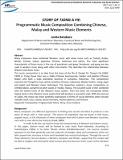| dc.description.abstract | Many composers have combined Western music with Asian music such as Turkish, Arabic, Berber, Persian, Indian, Japanese, Chinese, Indonesia and others. The most significant characteristic of Asian music is the use of pentatonic and gong. Pentatonic and gong are also used in western music along with other instruments. This describes the relationship between Western and Asian music.
This music composition is an idea from the story of the life of TjongA Fie. Tjong A Fie (1860-1920) or Tjong Yiauw Hian was a Hakka Chinese businessman, banker and kapitan (Chinese Major) who built a large plantation business in Sumatera, Indonesia. This composition examines the TjongA Fie story which combines Chinese, Indonesian (Malay rhythm: inang, joget and zapin) and Western music techniques. The researcher created a music composition as entitled above, using the six-pitch scales or modes, Huowu. The six-pitch scale is then combined with the twelve tones of the Western music system. Then the tones are transposed within twelve tones in the Western music system that will produce a new pitch scale. With the new set of scales, the music has more aesthetic expressions in terms of visual elements which include melodic motif, color, sound, atonal harmony, rhythm patterns, and texture. | en_US |

